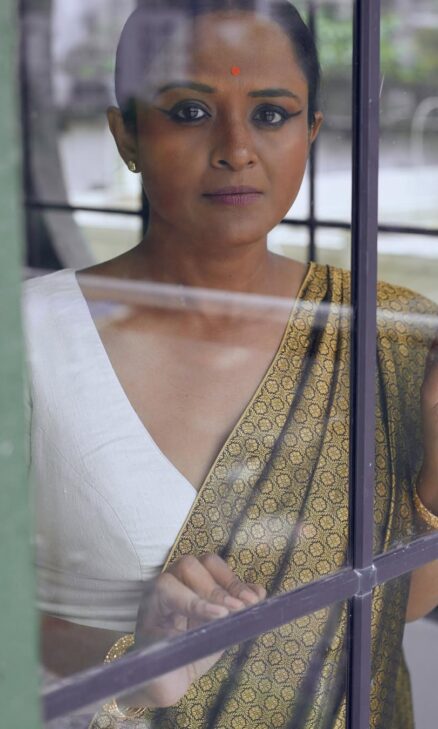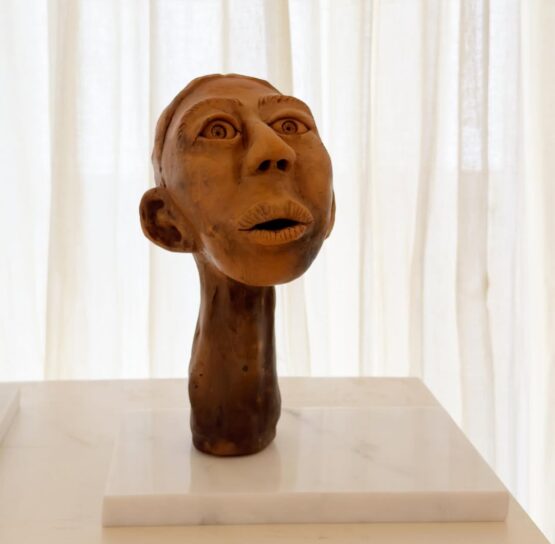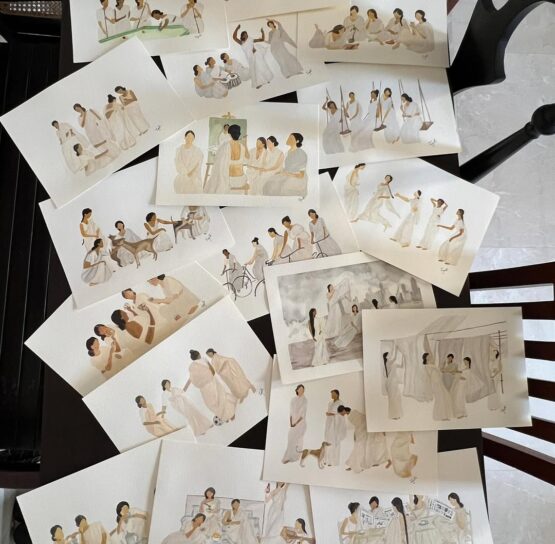Jayati Bose
Jayati Bose is a self-taught watercolour artist and sculptor whose work explores femininity, memory, and mythology through muted, earthy forms. Her illustrations and terracotta sculptures portray women unfiltered and unidealised, capturing raw presence and lived experience.
Self-taught watercolour artist and sculptor Jayati Bose builds a visual language at the intersection of femininity, mythology, and memory, themes that overlap and recur across her body of work. Born in Asansol, West Bengal and currently based in Mumbai, her practice spans watercolor illustrations and hand-moulded terracotta sculptures, with women taking the centre stage of her visual world. Across both disciplines, her subjects embody fluid forms and muted, earthy palette, a signature aesthetic that now marks her work. However, it is the simplicity that distinguishes Jayati’s works, all the more standing out in a contemporary art world where spectacle, provocation, or visual boldness often dominate its visual culture. Jayati’s works are an interplay of a lived experience and inherited memory, influenced by her Bengali upbringing. What immediately draws attention to the characters – goddesses, mothers, sisters, and storytellers–is the absence of how women have often been idealised over the years, particularly through over-beautification. The soft strokes of her watercolour illustrations, the absence of feminine features and the raw shapes of her terracotta forms make this apparent. Even in their softness, they convey as much emotional weight in communicating the hard-hitting realities observed by the artist. For instance, in Jayati’s celebrated series ‘Women at Leisure’, women in white saris are shown playing tug-of-war, sprawled in afternoon light, their friendships held together by laughter and long shadows, captured in unguarded moments that revolt against traditional expectations placed on women. The unfiltered portrayals have drawn the attention of brands like Paro by Good Earth, resulting in an exclusive 10-part series featuring Jayati’s reinterpretations of goddesses. Meanwhile, the artist’s sculptural journey began with the ‘Mrinmoyee’ series: ten terracotta busts inspired by the female protagonists in Rabindranath Tagore’s literary works, each carrying stories of pain and endurance in pursuit of individual freedom and social reform.With a Master’s in English Language and Literature and a Postgraduate Diploma in Journalism and Communication, Jayati’s portfolio reflects a prolific professional journey—spanning roles as a fashion journalist and stylist, and now an artist and sculptor. Drawing from her personal healthy journey, today Jayati’s work has also grown raw and stripped down. Her figures can be seen unadorned, bald, and earless, which are no longer reaching for validation from the onlookers, rather they are symbolic forms that capture what is left after pain, survival, and transformation. They instead confront the viewers with their raw presence, asserting a more honest truth of survival and selfhood– a shift that mirrors wider cultural conversations happening in India today about identity, gender, and selfhood.



Jayati speaks to Blur The Border :
Blur : As a creative, you’ve navigated both ends of the spectrum, from the fast-paced, audience-oriented worlds of fashion styling and journalism to the slower, more tactile practices of watercolour painting and sculpture. What inspired this shift?
Jayati : The shift wasn’t so much planned as it was quietly revealed to me, like something already waiting within, just needing the right conditions to surface. During the early days of the pandemic, while the world was collectively holding its breath, I found myself at the dining table with my then-eight-year-old daughter, trying to help her stay creatively engaged amidst the chaos. We explored painting together, tentatively at first, dabbling in watercolours, sketching birds, flowers, objects, human figures. It became a kind of shared ritual, a small but sacred act of making sense of the world through colour and form.
While others were sharing banana breads and balcony gardens in WhatsApp groups, we began posting our paintings, not with any grand intention, just as a way of documenting our days. Unexpectedly, these small acts of play and intimacy sparked conversations. Friends began nudging me gently, “Why isn’t this more than a hobby?”
And so, what began as a childlike gesture of guidance, teaching my daughter, spiraled into something deeper, tactile, and far more introspective. It was the first time I had slowed down enough to hear what my hands might be capable of saying, outside the deadlines and spectacle of styling or journalism. The transition felt less like a departure and more like a return, to something elemental, honest, and enduring.
Blur : How did your niche in watercolour painting and terracotta sculptures develop, particularly in depicting women and exploring themes of womanhood, nostalgia, and leisure within Bengali culture?
Jayati : My affinity for watercolours came instinctively. There’s something in their fluidity, the way pigment and water conspire on paper, that mirrors the ephemeral quality of memory and emotion. Watercolours allow for silence and softness, for things to remain unresolved and translucent, much like the inner lives of women I often portray.
Terracotta, on the other hand, feels rooted, earthy, primal, and deeply cultural. Growing up in Bengal, I was surrounded by the quiet brilliance of terracotta artisans. Their hands shaped mythology and daily life with equal reverence. I didn’t know then that their work had imprinted itself on my subconscious, but when I began sculpting much later, terracotta was the only medium that felt honest.
My themes, womanhood, nostalgia, leisure, emerged less as concepts and more as lived truths. I’ve always been drawn to moments when women are left alone with themselves, not defined by labour or roles, but by quiet agency. Bengali culture, with its rhythm of afternoons, its courtyard silences, its white saris and rituals of waiting, offers a fertile ground for that exploration. I suppose I return to it again and again, not out of sentimentality, but because it still holds questions I haven’t yet answered.
Blur : How has your artistic style evolved over the years?
Jayati : ‘In the beginning, my work was almost diaristic, intimate, immediate, and instinctive. I was painting to process, to feel, to remember. The early watercolours were quiet acts of observation, my daughter reading, women resting, a dog in sunlight. There was softness, even shyness, in those works. But over time, I felt the need to speak more sharply, to confront rather than just reflect.
That’s when the sculptural language began to shift as well. My terracotta works moved from figurative nostalgia to something more mythic and layered, women with tongues extended in refusal, hollow torsos that carried entire worlds within. I began to engage more deliberately with psycho-political themes, body, power, voice, silence.
Visually too, the work grew bolder. What began with delicate lines and soft shadows now embraces negative space, abstraction, and metaphor. I’ve learned that restraint can be radical. That beauty doesn’t have to be decorative. That sometimes, absence tells the story better than presence.
So the evolution, I think, has been from observation to confrontation, from painting what I see to sculpting what I refuse to unsee.
Blur : Your work moves between watercolour art and terracotta sculptures — two distinct yet tactile mediums. What draws you to working across these fields, and do they inform or influence each other in your creative process?
Jayati : I move between watercolour and terracotta like one might shift between breath and pulse. One is fluid, the other grounded. One evaporates into paper, the other hardens in fire. And yet, both demand surrender, they each require a willingness to lose control and trust the material.
Watercolour, with its unpredictability, mirrors the emotional landscapes I try to capture, fleeting, translucent, often unresolved. Terracotta, by contrast, feels ancestral. It carries weight, both literal and cultural. The clay remembers touch. It cracks if you force it. You must slow down, listen, mould it as you would a memory that resists shaping.
Though distinct, the two mediums speak to each other in the studio. Often, the looseness and spontaneity of my paintings allow my sculptures to stay intuitive, resisting overworking. And the physical labour of sculpting, kneading, carving, firing, grounds the ethereal lightness of watercolour, reminding me that ideas, like bodies, must be held with both care and courage.
I don’t see them as separate practices anymore. They are simply two dialects through which I explore the same questions, of form, of feminine presence, of time, decay, and grace.
Blur : Do you have a definitive process while creating? Are there any habits or rituals that help you get into a creative mindset?
Jayati : I wouldn’t call it a definitive process, it’s more like a rhythm I return to, one that allows for both discipline and drift. I begin most days in silence. No phone, no conversation, just light, tea, and a kind of hovering stillness. That pause is important, it lets the noise settle and the real questions rise.
In the studio, I often start by simply touching the materials, sometimes rereading a passage from a book or poetry, or revisit an old sketch or fragment of a thought I had scribbled months ago. The work doesn’t begin with grand concepts, it begins with fragments, an image, a memory, a line of poetry, a woman’s silence.
Music, too, plays a role, but not always. When I’m sculpting, rhythm helps, I often listen to Bengali folk, rabindra sangeet, chants, or even complete silence. When painting, especially with watercolour, I need to hear the water, how it moves, how it spreads. It’s a very embodied process.
There’s also a small ritual I never speak of, but perhaps I will now: before I begin any new piece, I touch my forehead to the table, just for a moment. Not out of superstition, but as a way of reminding myself that this act, of making, is sacred.
Blur : What comes first to you as a multidisciplinary artist — the art or the medium?
Jayati : For me, it’s never the medium that comes first. It’s always an emotion or a sensation, a tension, a question, an image that won’t let go. Sometimes it’s a memory that returns with a certain texture, or a sentence I overheard that carries emotional residue. The medium arrives later, like a language that chooses itself depending on what needs to be said.
If the idea feels fluid, elusive, or emotionally soft, I reach for watercolours. They allow for bleeding edges and half-spoken things. But if the thought is dense, something buried, bodily, or uncomfortable, then it needs clay. Terracotta has weight. It cracks. It needs fire. And sometimes that resistance is precisely what the work calls for.
I think being multidisciplinary has taught me that form should never be decorative, it must be in service of meaning. The art leads. The medium follows. Always.
Blur : Are there any other media you are looking to explore in the future?
Jayati : Yes, lately, I’ve been drawn to fabric. Not pristine bolts of cloth, but what’s already worn, frayed, abandoned. Discarded saris, torn upholstery, scraps that once held bodies and stories. There’s something profoundly intimate about working with fabric that has already lived a life, it carries scent, memory, weight.
I’m exploring textile tapestries and soft sculptures, where the material itself becomes both medium and meaning. Unlike clay or paint, which start as raw material, these fabrics come with their own narratives. Weaving these strips of old fabrics into them feels like a quiet act of mending, not just the textile, but something deeper. A form of reclamation.
I see this shift not as a departure from my existing practice, but an extension of it. Another way of speaking, this time in threads, folds, and the ghost of touch.
Blur : If you could collaborate with an artist from outside your discipline, who would it be and what would you want to create together?
Jayati : I’ve always been drawn to the intersections, where aesthetics meet systems, where beauty is entangled with power. Having studied English literature alongside economics and political science, my lens has always been both poetic and structural. I read images like texts, but I also trace the forces, economic, political, gendered, that shape those images into being.
One recent interdisciplinary project that stayed with me involved a designer and an economist collaborating to tell the economic story of Jamdani weaving, not merely as textile tradition, but as a living system of labour, inheritance, and fragility. It affirmed something I’ve always sensed; that art can be archival, investigative, even insurgent.
If I were to collaborate across disciplines, it would be with someone who brings ethnographic or economic rigour into the space of art-making, an anthropologist, perhaps, or a political economist. Together, I’d like to create a tactile narrative, through sculpture, textile, even sound, that maps not just beauty, but the invisible scaffolding behind it: women's labour, domestic economies, intergenerational skill, erasure, and endurance. A living archive where form becomes both testimony and resistance.
Blur : In today’s art landscape, how important is it for artists to be online? What advice would you give to emerging artists trying to build visibility and community?
Jayati : In today’s art landscape, being online isn’t optional, it’s one of the spaces where visibility, discourse and community are actively being shaped. But I also think there’s a difference between visibility and noise. The internet can amplify your work, yes, but it can also dilute it if you’re not intentional. As artists, our task is not just to show but to sustain, to create meaningfully, not just frequently.
For emerging artists, my advice would be to not chase algorithms, chase authenticity. Use the online space as an extension of your practice, not a performance of it. Let your digital presence reflect your obsessions, your process, your silences even. People don’t just respond to finished artworks, they respond to the honesty behind them.
Also, community matters. Don’t just post, listen, respond, support others. Some of the most meaningful collaborations and conversations I’ve had have started in quiet comment threads or shared DMs with photographers, curators, even historians. The internet can feel vast and impersonal, but if you use it thoughtfully, it can become an incredibly intimate and generous space.
Know more about Jayati:
Instagram: @bosejayati